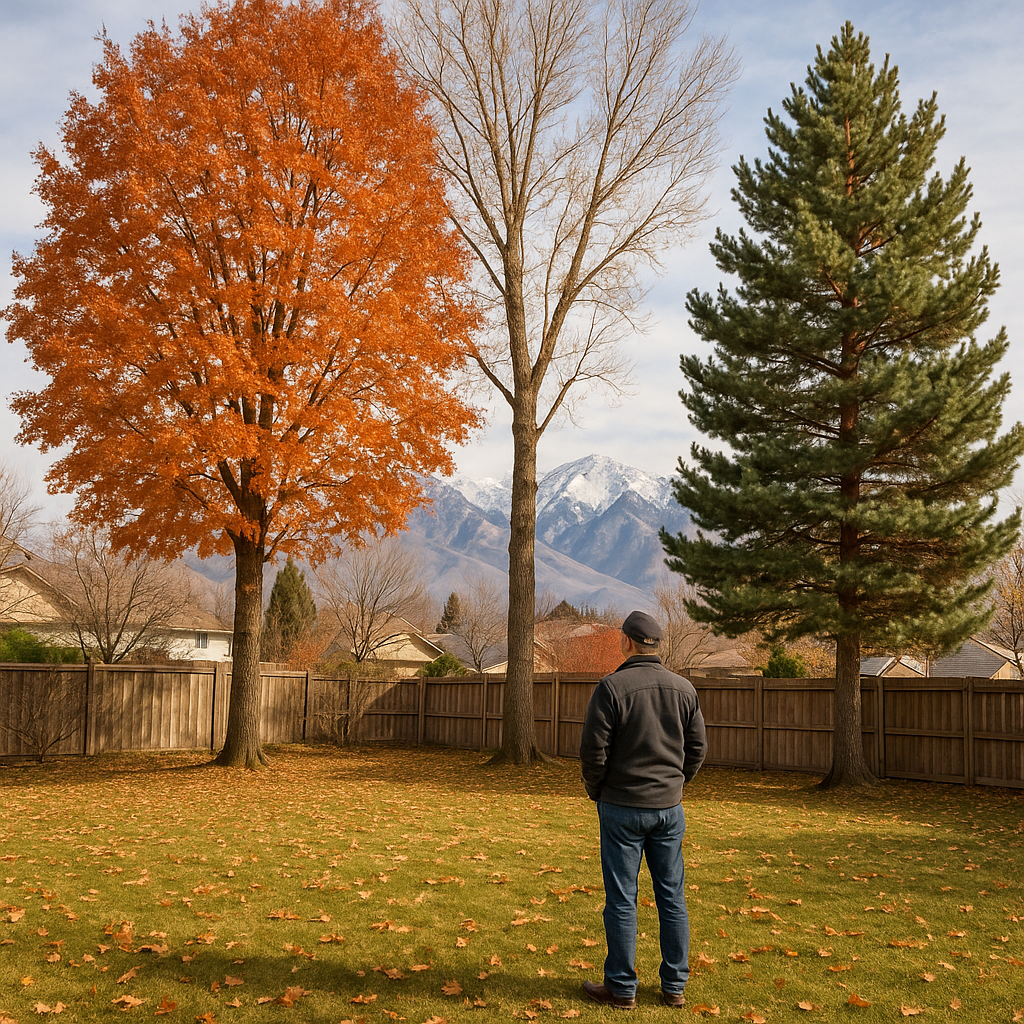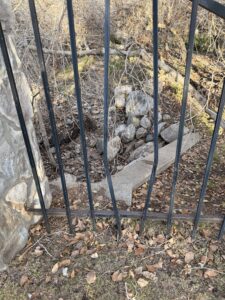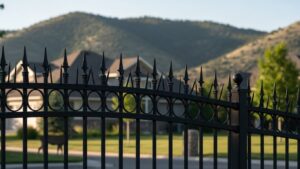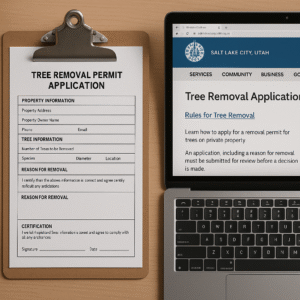When most homeowners think about taking care of their trees, they picture the fresh growth of spring. But here in Northern Utah, the smart homeowners are already acting in November. Fall tree care in Northern Utah can make the difference between healthy, resilient trees next spring—or costly storm damage and removals.
As temperatures drop and trees enter dormancy, November offers the ideal time for pruning, inspection, and preventive maintenance. Understanding the seasonal differences between fall and spring tree care helps you protect your property, improve safety, and maintain long-term tree health.
Why Fall Tree Care in Northern Utah Matters
Trees across the Wasatch Front and Cache Valley face unique challenges—dry summers, high winds, early snow, and fluctuating winter temperatures. These conditions create stress, especially for mature and ornamental trees. Late fall is your opportunity to address issues before freezing weather and heavy snow arrive.
Benefits of Fall Tree Care:
- Dormant pruning:Pruning in late fall helps trees heal faster and reduces disease risk.
- Easier inspection:With leaves gone, arborists can clearly see branch structure and hidden damage.
- Lower pest activity:Insects and fungi are less active, reducing infection risks.
- Preparation for storms:Removing weak limbs prevents winter breakage and property damage.
These benefits make fall tree care in Northern Utah one of the smartest investments homeowners can make before winter sets in.
Comparing Fall vs. Spring Tree Care
Homeowners often wonder, “Should I wait until spring to prune?” While spring care has its advantages, fall offers several key benefits you don’t get later in the year.
| Factor | Fall Tree Care (November) | Spring Tree Care (March–May) |
| Tree Condition | Dormant, stable; easier to inspect | Actively growing; can be sensitive |
| Pest Activity | Low; ideal for pruning | High; insects spread faster |
| Disease Risk | Reduced by cold weather | Increased due to warmth and moisture |
| Visibility of Structure | Excellent—no leaves | Limited; foliage hides weak limbs |
| Cost Efficiency | Prevents emergency removals | May require corrective work after damage |
This comparison shows why All Woods and other certified arborists recommend fall as the optimal time for tree inspection and pruning in Utah’s climate.
Effective Fall Tree Care in Northern Utah
To maximize protection, every homeowner should follow a few simple but critical steps. These not only reduce risk during winter storms but also improve growth and health next year.
1. Schedule a Professional Tree Inspection
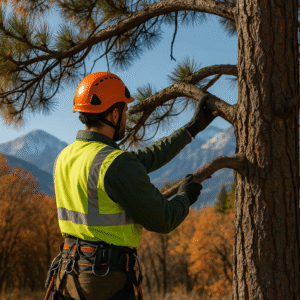
November is ideal for a certified arborist to assess your trees. They can spot structural issues—such as cracks, dead branches, or weak unions—that could fail under snow or wind. According to the Utah Division of Forestry, Fire & State Lands, structural defects are a leading cause of storm-related tree damage statewide.
2. Prune Strategically
Pruning during dormancy allows for cleaner cuts and reduces sap flow. All Woodsrecommends focusing on:
- Removing dead or diseased branches
- Thinning crowded limbs to improve air flow
- Shaping canopy structure for balance and light penetration
Proper pruning improves not just the look of your trees but also their strength against winter stress.
3. Protect Tree Roots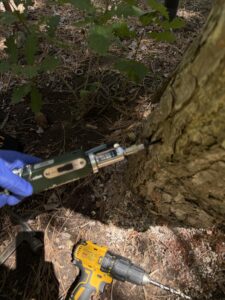
Late fall is also prime time to care for your soil and roots. Apply mulch around the base to regulate soil temperature and retain moisture during dry winter spells. Avoid piling mulch directly against the trunk to prevent rot.
4. Water Deeply Before Ground Freezes
In Northern Utah’s dry climate, trees need deep watering before soil freezes—especially younger or newly planted trees. The Utah State University Extension notes thatfall watering helps prevent winter desiccation, which can cause spring die-back.
5. Address Pests and Disease Early
Even though pest activity slows in fall, existing issues can carry into spring. Mountain pine beetles, for instance, have been increasingly active in Northern Utah due to warmer winters. Identifying stress indicators early—like reddish needles, pitch tubes, or sawdust—can help prevent severe pine beetle damagenext year.
What Happens If You Wait Until Spring?
Waiting until spring to assess or prune can lead to:
- Hidden damage:Snow and ice can cause unnoticed cracks or splits that worsen with spring growth.
- Higher costs:Emergency removals after winter storms often cost two to three times more than planned pruning in November.
- Pest outbreaks:Weak or damaged trees attract insects early in the warm season.
- Delayed growth:Overcrowded or diseased branches limit healthy bud development in spring.
A proactive approach this fall ensures you won’t face costly surprises when temperatures rise again.
Frequently Asked Questions About Fall Tree Care in Northern Utah
Q: Is it safe to prune all trees in fall?
A: Most deciduous trees benefit from fall pruning, but some spring-flowering species may prefer post-bloom pruning. A certified arborist can recommend the best schedule for your trees.
Q: Can I prune evergreens in November?
A: Light pruning is fine, but avoid heavy cuts late in the season. Evergreens should be inspected for beetle damage and structural stability before winter storms hit.
Q: How cold is too cold for tree work?
A: Most pruning and inspections can continue safely until temperatures consistently drop below freezing. In Northern Utah, that often means you have until early December for optimal work.
Q: What if my tree already has broken limbs from wind or snow?
A: Don’t wait until spring. Broken branches invite pests and decay. Professional cleanup and proper trimming now help prevent further structural failure.
The Cost Advantage: Fall Tree Care vs. Emergency Removal
| Service Type | Average Cost Range (Utah) | When It’s Needed |
| Preventive Pruning / Inspection | $200 – $600 | Scheduled in fall |
| Emergency Tree Removal | $1,000 – $3,000+ | After winter storm damage |
| Stump Grinding & Cleanup | $150 – $500 | Post-removal only |
Investing in fall tree care in Northern Utah pays off by preventing emergency expenses later. A $300 pruning job in November can eliminate the need for a $2,000 removal in February.
How to Prepare Your Property for Winter Weather
Beyond pruning and inspections, homeowners can take simple steps to protect their landscape:
- Tie or cable young or top-heavy trees.
- Clear leaves and debris around roots to prevent fungus.
- Inspect nearby utility lines and structures for potential branch interference.
- Ensure snow plows or salt won’t damage exposed roots or bark.
Why November Is the Perfect Time to Call All Woods Tree Service
All Woods Tree Service specializes in fall tree care in Northern Utah, offering professional pruning, inspections, and emergency prevention for residential and commercial properties. With years of local experience, our certified team understands how Utah’s climate impacts tree health and safety.
We help homeowners:
- Identify and correct hidden structural issues
- Protect trees from winter stress and pests
- Improve long-term growth and curb appeal
- Avoid costly emergency removals
Taking action this November could save you thousands and give you peace of mind all winter long.
Ready to protect your trees before the snow hits?Contact All Woods Tree Service today for a professional fall inspection and custom tree care plan.

